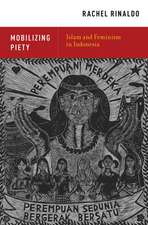Women and Democracy in Cold War Japan: SOAS Studies in Modern and Contemporary Japan
Autor Jan Bardsleyen Limba Engleză Paperback – 16 dec 2015
| Toate formatele și edițiile | Preț | Express |
|---|---|---|
| Paperback (1) | 250.92 lei 43-57 zile | |
| Bloomsbury Publishing – 16 dec 2015 | 250.92 lei 43-57 zile | |
| Hardback (1) | 773.81 lei 43-57 zile | |
| Bloomsbury Publishing – 18 iun 2014 | 773.81 lei 43-57 zile |
Din seria SOAS Studies in Modern and Contemporary Japan
- 21%
 Preț: 218.00 lei
Preț: 218.00 lei - 30%
 Preț: 510.25 lei
Preț: 510.25 lei - 23%
 Preț: 228.76 lei
Preț: 228.76 lei - 22%
 Preț: 231.63 lei
Preț: 231.63 lei - 30%
 Preț: 539.84 lei
Preț: 539.84 lei - 23%
 Preț: 228.94 lei
Preț: 228.94 lei - 22%
 Preț: 256.85 lei
Preț: 256.85 lei - 21%
 Preț: 218.74 lei
Preț: 218.74 lei - 13%
 Preț: 231.89 lei
Preț: 231.89 lei - 30%
 Preț: 540.54 lei
Preț: 540.54 lei - 22%
 Preț: 225.59 lei
Preț: 225.59 lei - 22%
 Preț: 241.15 lei
Preț: 241.15 lei - 13%
 Preț: 259.07 lei
Preț: 259.07 lei - 21%
 Preț: 235.20 lei
Preț: 235.20 lei - 13%
 Preț: 257.97 lei
Preț: 257.97 lei - 30%
 Preț: 597.56 lei
Preț: 597.56 lei - 22%
 Preț: 257.97 lei
Preț: 257.97 lei - 21%
 Preț: 218.74 lei
Preț: 218.74 lei - 22%
 Preț: 256.95 lei
Preț: 256.95 lei - 30%
 Preț: 540.96 lei
Preț: 540.96 lei - 22%
 Preț: 224.94 lei
Preț: 224.94 lei -
 Preț: 323.56 lei
Preț: 323.56 lei - 30%
 Preț: 656.90 lei
Preț: 656.90 lei - 12%
 Preț: 259.52 lei
Preț: 259.52 lei - 21%
 Preț: 218.18 lei
Preț: 218.18 lei - 22%
 Preț: 256.59 lei
Preț: 256.59 lei - 21%
 Preț: 218.47 lei
Preț: 218.47 lei - 30%
 Preț: 567.75 lei
Preț: 567.75 lei
Preț: 250.92 lei
Preț vechi: 287.86 lei
-13% Nou
Puncte Express: 376
Preț estimativ în valută:
48.01€ • 50.26$ • 39.96£
48.01€ • 50.26$ • 39.96£
Carte tipărită la comandă
Livrare economică 31 martie-14 aprilie
Preluare comenzi: 021 569.72.76
Specificații
ISBN-13: 9781474269278
ISBN-10: 1474269273
Pagini: 256
Ilustrații: 14 bw illus
Dimensiuni: 156 x 234 x 14 mm
Greutate: 0.36 kg
Editura: Bloomsbury Publishing
Colecția Bloomsbury Academic
Seria SOAS Studies in Modern and Contemporary Japan
Locul publicării:London, United Kingdom
ISBN-10: 1474269273
Pagini: 256
Ilustrații: 14 bw illus
Dimensiuni: 156 x 234 x 14 mm
Greutate: 0.36 kg
Editura: Bloomsbury Publishing
Colecția Bloomsbury Academic
Seria SOAS Studies in Modern and Contemporary Japan
Locul publicării:London, United Kingdom
Caracteristici
Places Japanese practices within a larger framework, contributing to debates about global postfeminist culture
Notă biografică
Jan Bardsley is Associate Professor and Chair in the Department of Asian Studies at the University of North Carolina, Chapel Hill, USA.
Cuprins
1. Introduction: Tales of the Kitchen Princess2. Dueling Etiquettes: Mrs. Mogi takes on the Occupationnaires 3. The Housewife Debate of 1955 4. What Women Want: The Postwar Appetite5. Fashioning the People's Princess: Shoda Michiko and the Royal Wedding of 19596. Japan's Miss Universe: Beauty Contests and Postwar Democracy7. From the Housewife's Kitchen to the Witches' Den: Fantasies of Female Power in Enchi Fumiko's MasksBibliographyIndex
Recenzii
[This] valuable book . will be a great read for both students and scholars of postwar discourses on gender in Japan.
Richly evidenced and engrossing ... This volume provides the reader with an insightful and well researched analysis of gender roles and discussions in post-war Japan, and is a welcome addition to the literature.
[T]his a fascinating book that offers a compelling look at how the 'Japanese housewife' was mobilized in debates over postwar democracy. It will be of great interest to those who study postwar Japanese women's history and literature.
The richness and variety of the book's sources, and the consistently high level of Bardsley's analysis across multiple textual and visual genres, make her account convincing, informative, and even entertaining ... Women and Democracy in Cold War Japan is an engaging and intellectually stimulating piece of scholarship that will enhance discussions on the history of Japan's Allied Occupation and of postwar Japan, on gender in modern Japan and in Cold War politics, and on the cultural dimensions of U.S.-Japan relations.
Through close readings of popular media-from contentious letters to newspaper editors to debates covered in women's magazines, from tales of flawed fashionistas to satirical cartoons-Women and Democracy in Cold War Japan takes an innovative approach to the gender politics shaping Japan in the 1950s. Jan Bardsley effectively challenges the notion that the liberation of Japanese women was primarily the result of the American occupation of Japan after World War II. In addition, her analysis of the media construction of housewives, princesses, and beauty queens places Japan's postwar era squarely in the geopolitics of the Cold War. Accessible and provocative, Women and Democracy in Cold War Japan will be a very useful book for classes in gender studies in a variety of disciplines.
In Women and Democracy in Cold War Japan, Jan Bardsley invites us into a dynamic world of post-WWII Japan where the process of "democratization" initiated by American occupiers has unleashed a series of events and controversies involving women, homes, and nation. Offering fascinating tales of "Kitchen Princess," "Beauty Queen," "Real Estate Siren," and "Desiring Women," all of whom enlivened the Cold War Japan with their womanly determination and domestic ingenuity, Bardsley gives us an enchanting moment to re-imagine Japan in a manner far more complex and nuanced than ever attempted before. Against the backdrop of constitutional reform, gender democratization, and domestic modernization, Japanese women were historical agents of exceptional complexity, whose sentiments and practices hardly if ever followed any predictable route. Re-introducing women and the home to the center stage of the postwar Japanese history, Bardsley's book charts a new territory of analysis where richness of archival research is coupled with deftness of storytelling to reward its readers.
Richly evidenced and engrossing ... This volume provides the reader with an insightful and well researched analysis of gender roles and discussions in post-war Japan, and is a welcome addition to the literature.
[T]his a fascinating book that offers a compelling look at how the 'Japanese housewife' was mobilized in debates over postwar democracy. It will be of great interest to those who study postwar Japanese women's history and literature.
The richness and variety of the book's sources, and the consistently high level of Bardsley's analysis across multiple textual and visual genres, make her account convincing, informative, and even entertaining ... Women and Democracy in Cold War Japan is an engaging and intellectually stimulating piece of scholarship that will enhance discussions on the history of Japan's Allied Occupation and of postwar Japan, on gender in modern Japan and in Cold War politics, and on the cultural dimensions of U.S.-Japan relations.
Through close readings of popular media-from contentious letters to newspaper editors to debates covered in women's magazines, from tales of flawed fashionistas to satirical cartoons-Women and Democracy in Cold War Japan takes an innovative approach to the gender politics shaping Japan in the 1950s. Jan Bardsley effectively challenges the notion that the liberation of Japanese women was primarily the result of the American occupation of Japan after World War II. In addition, her analysis of the media construction of housewives, princesses, and beauty queens places Japan's postwar era squarely in the geopolitics of the Cold War. Accessible and provocative, Women and Democracy in Cold War Japan will be a very useful book for classes in gender studies in a variety of disciplines.
In Women and Democracy in Cold War Japan, Jan Bardsley invites us into a dynamic world of post-WWII Japan where the process of "democratization" initiated by American occupiers has unleashed a series of events and controversies involving women, homes, and nation. Offering fascinating tales of "Kitchen Princess," "Beauty Queen," "Real Estate Siren," and "Desiring Women," all of whom enlivened the Cold War Japan with their womanly determination and domestic ingenuity, Bardsley gives us an enchanting moment to re-imagine Japan in a manner far more complex and nuanced than ever attempted before. Against the backdrop of constitutional reform, gender democratization, and domestic modernization, Japanese women were historical agents of exceptional complexity, whose sentiments and practices hardly if ever followed any predictable route. Re-introducing women and the home to the center stage of the postwar Japanese history, Bardsley's book charts a new territory of analysis where richness of archival research is coupled with deftness of storytelling to reward its readers.













